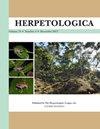巴拿马巴罗科罗拉多岛Anolis蜥蜴50年的观测
IF 1.1
3区 生物学
Q2 ZOOLOGY
引用次数: 0
摘要
摘要:本文介绍了巴拿马巴罗科罗拉多岛(Barro Colorado Island) 50年(1971-2020)年度人口普查结果。主要目的是评估为什么年终人口普查的丰度每年都有很大的变化,为什么它会随着时间的推移而下降。丰度与年降雨量呈负相关,其中90%发生在产卵的雨季。蜥蜴的数量与降雨间接相关,这是通过蜥蜴卵和它们的主要捕食者——扶桑蚁之间的相互作用实现的。当降雨量相对较高时,更多的卵被蚂蚁杀死,因为蚂蚁比降雨量相对较低时更活跃,遇到更多的卵。虽然降雨可以解释丰度的变化,但它并没有随着时间的推移而改变,因此可能不能解释丰度的总体下降。AICc分析的模型选择确定了与丰度相关的另外两个因素。丰度与滞后1年的南方涛动指数(SOI)呈正相关,高SOI(和高丰度)与凉爽潮湿的La Niña条件相关,低值与干燥温暖的El Niño条件相关。低丰度与干燥和温暖的El Niño条件(低SOI)相关的预测与丰度与降雨量的负相关(低丰度与高降雨量相关)相冲突。丰度与年最低气温呈负相关。在人口普查期间,Tmin的增加与丰度下降之间的联系机制尚不清楚。三种气候因素与蜥蜴的数量有关,但它们都不能解释为什么数量下降。第三个目标是在降雨模式下研究石菖蒲群落物种丰富度和优势度之间的关系。热带森林的最大丰富度通常为7-8种。巴拿马研究点的物种丰富度较高,但在所有记录中占96%以上,这是出乎意料的物种优势度。不同立地间的比较结果表明,一个群落中Anolis的种类数量与年降雨量有关,优势度与降雨的季节性有关。干燥森林的油葵种类很少,而潮湿森林的油葵种类多达7-8种。雨季较短的森林(降雨量为100 ~ 100毫米的月份),一个物种的个体很可能在群落中占主导地位。本文章由计算机程序翻译,如有差异,请以英文原文为准。
Fifty Years of Observations on Anolis Lizards at Barro Colorado Island, Panama
Abstract: I present the results of 50 yr (1971–2020) of annual censuses of Anolis apletophallus on Barro Colorado Island, Panama. The main objectives were to assess why abundance in end-of-the-year censuses varied substantially from year to year and why it declined over time. Abundance was negatively correlated with annual rainfall, 90% of which occurs in the wet season when eggs are laid. Lizard abundance is indirectly linked to rainfall through the interaction between Anolis eggs and their major predator, Solenopsis ants. More eggs are killed by ants when rainfall is relatively high because ants are more active and encounter more eggs than when rainfall is relatively low. While rainfall accounts for variability in abundance, it has not changed over time and thus may not account for the overall decline in abundance. Model selection of AICc analyses identified two other factors correlated with abundance. Abundance was positively correlated with the Southern Oscillation Index (SOI) lagged by 1 yr. High SOI (and high abundance) is associated with cool and wet La Niña conditions and low values with dry and warm El Niño conditions. The prediction that low abundance is associated with dry and warm El Niño conditions (low SOI) conflicts with the negative correlation between abundance and rainfall where low abundance is associated with high rainfall. Moreover, abundance was negatively correlated with Tmin (minimum annual temperature). The mechanism by which increasing Tmin during the census period is linked to declining abundance is unknown. Three climatic factors are correlated with lizard abundance, but none of them explain why abundance has declined. A third objective was to examine the relationship between species richness and species dominance of Anolis communities with respect to rainfall patterns. Tropical forests typically have a maximal richness of 7–8 species. Our study sites in Panama have high species richness, but Anolis apletophallus individuals made up ≥96% of all records, an unexpected level of species dominance. Comparisons among sites suggest that the number of Anolis species in a community is related to annual rainfall, and dominance is related to seasonality of rainfall. Dry forests have few Anolis species and wet forests have as many as 7–8 species. Forests with short wet seasons (months with >100 mm rainfall) have a high likelihood that individuals of one species will dominate the community.
求助全文
通过发布文献求助,成功后即可免费获取论文全文。
去求助
来源期刊

Herpetologica
生物-动物学
CiteScore
4.60
自引率
0.00%
发文量
27
审稿时长
>12 weeks
期刊介绍:
Established in 1936, Herpetologica is a quarterly peer-reviewed journal serving herpetologists, biologists, ecologists, conservationists, researchers and the scientific community. The journal contains original research papers and essays about the biology of reptiles and amphibians, and covers many relevant topics including: behavior, conservation, ecology, genetics, morphology, physiology and taxonomy.
 求助内容:
求助内容: 应助结果提醒方式:
应助结果提醒方式:


